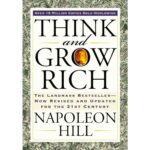LISTEN NOW
Outline: Think and Grow Rich by Napoleon Hill
Outline
Expand to Read ...
1. Introduction
- Purpose: A guide to achieving wealth and success by controlling thoughts and cultivating positive thinking.
- Historical Context: Published in 1937 during the Great Depression, it was welcomed as an antidote to hard times and remains a popular self-help classic.
- Core Idea: Thoughts shape reality. Success stems from a clear purpose, persistent action, faith, and proper planning.
- Content Structure:
- Principles of success
- Steps for transforming thoughts into riches
- Historical examples from interviews with 500 successful individuals
2. Key Principles and Strategies
2.1 Thoughts Create Reality
- Concept: Success-consciousness leads to success; failure-consciousness leads to failure.
- Steps:
- Define a single, specific goal (definite purpose).
- Develop an all-consuming desire for that goal.
- Pursue it with persistence and faith.
2.2 Desire
- Core Principle: Strong, specific desires are the foundation of success.
- Examples:
- Edwin Barnes partnered with Thomas Edison through relentless determination.
- Marshall Field rebuilt his department store after the Great Chicago Fire.
- Actionable Steps:
- Define your goal precisely.
- Commit to achieving it with unwavering focus.
- Visualize and affirm your goal twice daily.
2.3 Faith and Autosuggestion
- Faith: Believing in your goal and ability to achieve it is essential.
- Autosuggestion:
- Repeatedly affirm your goals with emotion to influence your subconscious mind.
- Visualize yourself already achieving the goal.
2.4 Specialized Knowledge and Master Mind Groups
- Specialized Knowledge:
- Focus on practical, industry-specific knowledge rather than general education.
- Continuously learn and adapt.
- Master Mind Groups:
- Surround yourself with individuals who provide expertise, motivation, and accountability.
- Example: Henry Ford relied on his team for technical expertise.
2.5 Imagination
- Types:
- Synthetic: Rearranging existing ideas.
- Creative: Generating new ideas through inspiration.
- Importance: Imagination fuels plans and ideas, which lead to innovation.
- Examples:
- Asa Candler transformed Coca-Cola into a global brand with imaginative marketing.
- A clergyman raised $1 million for a school through a visionary plan.
2.6 Planning
- Action Steps:
- Create a detailed plan.
- Adjust and refine the plan after setbacks.
- Maintain persistence.
- Key Insight: Temporary defeat signals flaws in the plan, not failure.
2.7 Decisiveness
- Success Trait: Quick, firm decision-making differentiates successful people.
- Procrastination:
- A common failure trait.
- Leads to indecisiveness and missed opportunities.
- Example: The American Revolution began with decisive actions by the Continental Congress.
2.8 Persistence
- Definition: The willpower to continue despite obstacles.
- Four Requirements for Persistence:
- A clear goal.
- A concrete plan.
- Positive thinking.
- Supportive Master Mind group.
- Example: Howard Schultz persisted with Starbucks despite early losses.
2.9 Overcoming Fear and Negative Influences
- Major Fears:
- Poverty
- Criticism
- Poor health
- Loss of love
- Old age
- Death
- Eliminating Fear:
- Replace fears with positive thoughts.
- Avoid worry and focus on proactive problem-solving.
- Negative Influences:
- Identify and block sources of negativity (both internal and external).
2.10 Subconscious Mind and the Sixth Sense
- Subconscious Mind:
- Collects and processes dominant thoughts and emotions.
- Responds to autosuggestion and faith.
- Sixth Sense:
- Intuition or hunches derived from creative imagination.
- Develops gradually through the principles outlined in the book.
3. Supporting Concepts
3.1 Sex Energy Transmutation
- Concept: Redirect sexual energy into creative and productive outlets.
- Examples: Historical figures like Napoleon and Lincoln harnessed this energy for greatness.
3.2 Fear of Criticism and Failure
- Impact: These fears stifle ambition and innovation.
- Solution: Build self-confidence and detach from others’ opinions.
4. Practical Applications
4.1 Steps to Achieving Wealth
- Define the exact amount of money or goal.
- Decide what you’ll give to achieve it.
- Set a specific timeline.
- Create and execute a clear plan.
- Write and repeat your goal daily.
4.2 Master Mind Group
- Recruit people with complementary skills and shared commitment.
- Meet regularly to brainstorm and refine plans.
4.3 Self-Analysis for Success
- Identify personal weaknesses using reflection questions.
- Actively address areas of improvement.
5. Conclusion
- Core Insight: You have the power to control your thoughts and thereby shape your destiny.
- Final Call to Action:
- Embrace positive thinking.
- Define your purpose and pursue it with relentless faith and persistence.
- Use the outlined principles to master your thoughts and achieve life’s riches.

 Buy on Amazon
Buy on Amazon